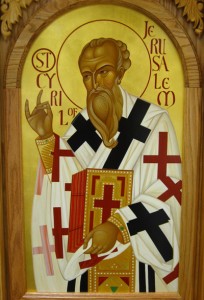Today we celebrate the feast of St. Cyril of Jerusalem. I have been familiar with Cyril for many years through his Catecheses, written about 347 or 348 AD, just a couple of years before he became the bishop of Jerusalem. But only recently have I learned about the pilgrimage of Etheria  to Jerusalem in about the year 385 AD: she wrote an account of her journey, including detailed descriptions of the liturgies in Jerusalem. When we look at Cyril’s writings from just before his episcopal ministry and Etheria’s account from several decades later, we can see what Cyril accomplished during his years as bishop.
to Jerusalem in about the year 385 AD: she wrote an account of her journey, including detailed descriptions of the liturgies in Jerusalem. When we look at Cyril’s writings from just before his episcopal ministry and Etheria’s account from several decades later, we can see what Cyril accomplished during his years as bishop.
His list of achievements is phenomenal. But to understand Cyril’s importance, you have to know a bit about Jerusalem’s place in the Church at the time. When Constantine legalized Christianity in 312, the Church began transforming herself from a private and secretive group into a public institution. The Church is public by her very nature, but the circumstances of Roman persecution had kept her, so to speak, crammed into a little box; the lid removed, she began to unfold her true dimensions. In this time of rapid change her liturgies, which had been secret and held in private homes and exclusive, became large, public, and impressive. At this crucial moment for the development of the liturgy, attention turned to Jerusalem.
The importance of Jerusalem for the new Christian world can be seen in the fact that Constantine’s own mother went on pilgrimage to the sacred sites in 325 AD. Under constant persecutions, Christians had focused on how the liturgy connected them with what is beyond this world, with heaven; the persecutions safely in the past, Christians could begin to think about how the liturgy also connected them with the world around them. And nothing in this world seemed so closely connected to the liturgical mysteries than the sacred sites of Jerusalem. Etheria’s pilgrimage was part of a wave of visitors to Jerusalem who came to worship at the sacred places and went home to report how worship was conducted in Jerusalem—Jerusalem, the original location where Christ offered his sacrifice!
Enter St. Cyril. He became bishop of Jerusalem toward the beginning of this flood of pilgrimages, and he shaped Jerusalem’s liturgies in response to the new need over the course of many decades. When pilgrims returned home to shape their local liturgies on what they had seen in Jerusalem, it was Cyril’s liturgies they brought home. Consequently, we can trace back to this one man’s influence:
- The adoption of the divine office as a public function of the Church rather than a private devotion of monks.
- Special readings at Mass and in the office for saints’ feasts and for different liturgical seasons (the proper of saints and the proper of seasons).
- The liturgical veneration of saints from across the whole church instead of the veneration of local martyrs only.
- The use of liturgical vestments, incense at the gospel, and other familiar elements in the Mass.
- The liturgies of Passion Sunday, Palm Sunday, Holy Thursday, and Good Friday, as well as the practice of not having Mass on Holy Saturday.
- The series of readings we all know at the Easter Vigil.
So if you read the breviary today, thank Cyril. If you are looking forward to the beautiful Holy Week liturgies, thank Cyril. If you celebrate Cyril’s feast today, thank Cyril—he put us on track toward celebrating more than just local martyrs. And if you are awed by how much this one good pastor of the fourth century did for the Church, thank God!

